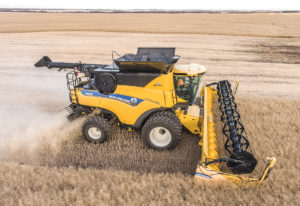Description
Conventional grain combines are useful for harvesting large-scale seed fields. These self-propelled combines are designed for major grain crops but can be adjusted to handle many types of grass seed. Recent models are highly instrumented, and the operator can control all cleaning functions from an air-conditioned cab. A combine consists of a header assembly, threshing mechanism, separating and cleaning unit, storage bin, power train, and a cab with all the controls. The header assembly consists of a reel, cutter bar, and an auger. Grass stems are severed just below the seed heads by the cutter bar, and the seed heads are fed into the thresher by an auger. Seed is separated from the seed heads and transported into the storage bin, while stems and trash are blown out the rear of the combine. Some grass species are cut first with a swather to aid in field drying. A pick-up mechanism mounted on the combine’s header is then used to gather the crop into the combine. Swathers and pick-up devices are marketed by combine manufacturers and independents. A specialized stripping header assembly that replaces the standard header has been used effectively by commercial grass seed growers. The seed heads are stripped rather than cut before entering the threshing section of the combine. This reduces the amount of vegetative material to be removed from the threshing and cleaning units. Grain combines are suited for high-production, commercial, grass-seed farms, but they are very expensive. Small-plot combines are also available and are used for harvesting many native grasses and some forbs. They are not suited for rocky, uneven terrain or grasses that are excessively chaffy.
References / Additional Information
Harmond, J.E.; Smith, J.E.; Park, J.K. 1961. Harvesting the seeds of grasses and legumes. Yearbook of Agriculture 1961: 181-188.
Pedrini, S.; Gibson-Roy, P. Trivedi, C.; and others. 2020. Collection and production of native seeds for ecological restoration. Restoration Ecology. 28(S3): S228-S238.


